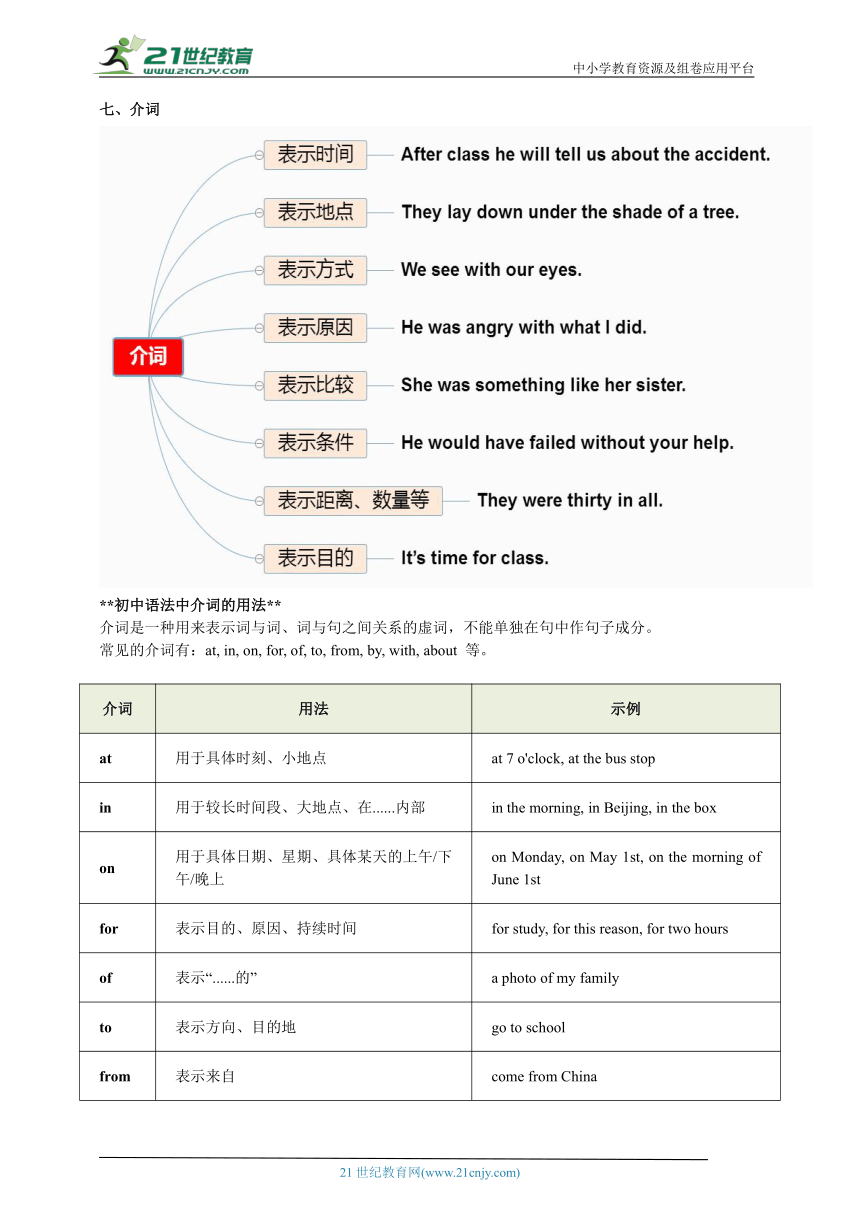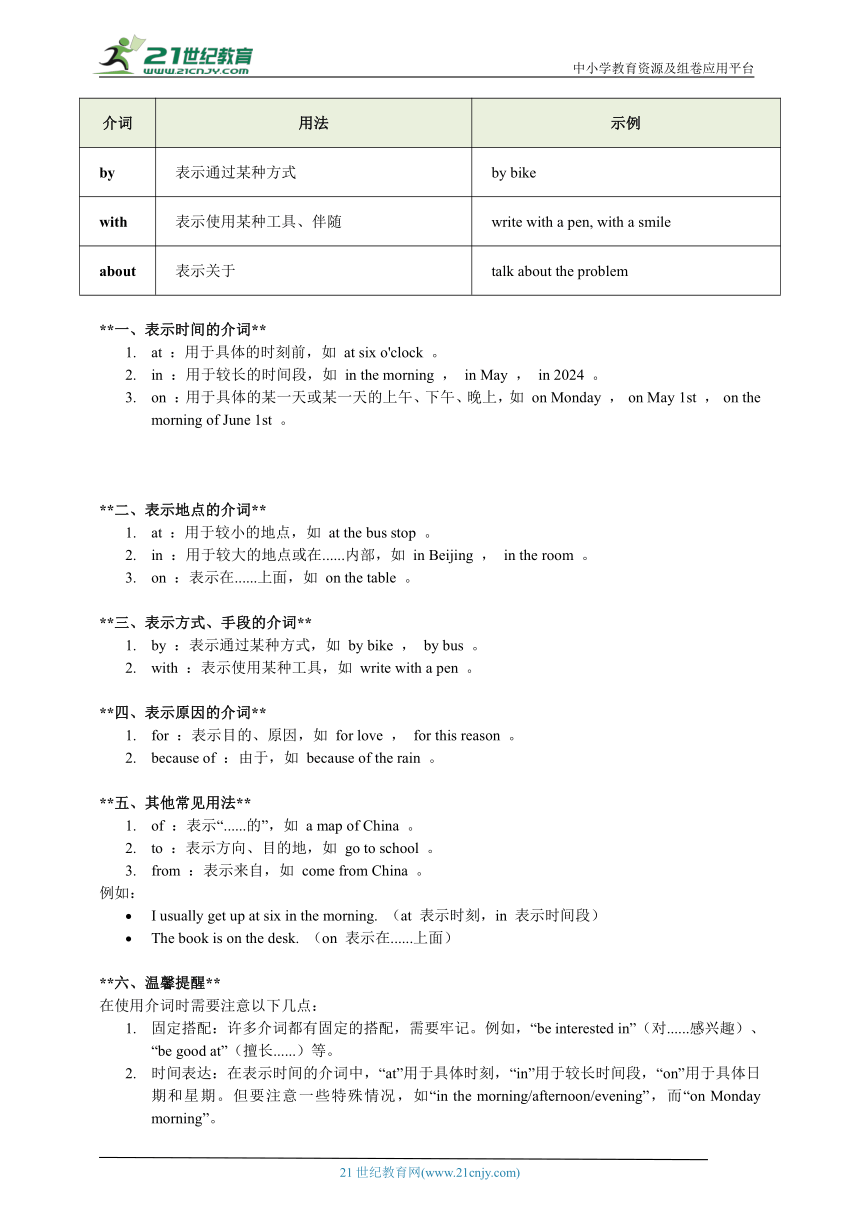七、介词-精讲精练【思维导图突破初中英语语法】(含答案)
文档属性
| 名称 | 七、介词-精讲精练【思维导图突破初中英语语法】(含答案) |  | |
| 格式 | doc | ||
| 文件大小 | 249.4KB | ||
| 资源类型 | 试卷 | ||
| 版本资源 | 通用版 | ||
| 科目 | 英语 | ||
| 更新时间 | 2024-07-23 10:01:17 | ||
图片预览


文档简介
中小学教育资源及组卷应用平台
七、介词
**初中语法中介词的用法**
介词是一种用来表示词与词、词与句之间关系的虚词,不能单独在句中作句子成分。
常见的介词有:at, in, on, for, of, to, from, by, with, about 等。
介词 用法 示例
at 用于具体时刻、小地点 at 7 o'clock, at the bus stop
in 用于较长时间段、大地点、在......内部 in the morning, in Beijing, in the box
on 用于具体日期、星期、具体某天的上午/下午/晚上 on Monday, on May 1st, on the morning of June 1st
for 表示目的、原因、持续时间 for study, for this reason, for two hours
of 表示“......的” a photo of my family
to 表示方向、目的地 go to school
from 表示来自 come from China
by 表示通过某种方式 by bike
with 表示使用某种工具、伴随 write with a pen, with a smile
about 表示关于 talk about the problem
**一、表示时间的介词**
at :用于具体的时刻前,如 at six o'clock 。
in :用于较长的时间段,如 in the morning , in May , in 2024 。
on :用于具体的某一天或某一天的上午、下午、晚上,如 on Monday , on May 1st , on the morning of June 1st 。
**二、表示地点的介词**
at :用于较小的地点,如 at the bus stop 。
in :用于较大的地点或在......内部,如 in Beijing , in the room 。
on :表示在......上面,如 on the table 。
**三、表示方式、手段的介词**
by :表示通过某种方式,如 by bike , by bus 。
with :表示使用某种工具,如 write with a pen 。
**四、表示原因的介词**
for :表示目的、原因,如 for love , for this reason 。
because of :由于,如 because of the rain 。
**五、其他常见用法**
of :表示“......的”,如 a map of China 。
to :表示方向、目的地,如 go to school 。
from :表示来自,如 come from China 。
例如:
I usually get up at six in the morning. (at 表示时刻,in 表示时间段)
The book is on the desk. (on 表示在......上面)
**六、温馨提醒**
在使用介词时需要注意以下几点:
固定搭配:许多介词都有固定的搭配,需要牢记。例如,“be interested in”(对......感兴趣)、“be good at”(擅长......)等。
时间表达:在表示时间的介词中,“at”用于具体时刻,“in”用于较长时间段,“on”用于具体日期和星期。但要注意一些特殊情况,如“in the morning/afternoon/evening”,而“on Monday morning”。
地点表达:“at”用于小地点,“in”用于大地点,但也有一些特殊情况,比如“arrive at + 小地点”(如 arrive at the station),“arrive in + 大地点”(如 arrive in Beijing)。
动词与介词的搭配:有些动词与不同的介词搭配会有不同的意思。例如,“look at”(看)和“look for”(寻找)。
逻辑关系:要根据句子表达的逻辑关系选择合适的介词。比如“thanks for”(因为......而感谢)和“thanks to”(多亏)。
语境理解:同一个词在不同的语境中可能需要不同的介词。需要结合上下文来准确选择。
**七、练习与巩固**
牛刀小试-单项选择题
We have lunch ______ 12 o'clock.
A. at B. in C. on
He was born ______ May 1st, 1998.
A. in B. on C. at
The man ______ black is my teacher.
A. in B. with C. of
I go to school ______ bike.
A. by B. on C. in
Please be careful ______ your work.
A. with B. of C. for
They are talking ______ the phone.
A. on B. in C. at
The teacher is very strict ______ us.
A. with B. to C. for
This is a photo ______ my family.
A. of B. for C. about
He is good ______ playing football.
A. at B. in C. on
The book is different ______ that one.
A. from B. of C. to
答案:
A (“at”用于具体时刻)
B (“on”用于具体日期)
A (“in + 颜色”表示“穿着......颜色的衣服”)
A (“by bike”表示“骑自行车”)
A (“be careful with”表示“对......小心”)
A (“on the phone”表示“在打电话”)
A (“be strict with”表示“对......严格”)
A (“a photo of...”表示“......的照片”)
A (“be good at”表示“擅长......”)
A (“be different from”表示“与......不同”)
巩固加强-结合语句意思,在空格处填入一个合适的单词
I usually get up ______ six in the morning.
My birthday is ______ March.
The girl ______ red is my sister.
He goes to work ______ bus every day.
Don't be late ______ class.
They are waiting ______ the bus stop.
I'm very happy ______ you.
The pen is ______ the desk.
We are interested ______ English.
Thank you ______ your help.
答案
at
in
in
by
for
at
with
on
in
for
解析
“at”用于具体时刻,“six”是具体的时刻,所以用“at”。
“in”用于月份,“March”是月份,用“in”。
“in + 颜色”表示“穿着......颜色的衣服”,所以用“in”。
“by + 交通工具”表示“乘坐......交通工具”,“bus”是交通工具,用“by”。
“be late for”是固定短语,意思是“......迟到”。
“at the bus stop”表示“在公交车站”,是固定搭配。
“be happy with”表示“对......感到高兴”。
“on the desk”表示“在桌子上”,是固定搭配。
“be interested in”表示“对......感兴趣”,是固定短语。
“Thank you for...”表示“因......而感谢”,是固定用法。
21世纪教育网 www.21cnjy.com 精品试卷·第 2 页 (共 2 页)
HYPERLINK "http://21世纪教育网(www.21cnjy.com)
" 21世纪教育网(www.21cnjy.com)
七、介词
**初中语法中介词的用法**
介词是一种用来表示词与词、词与句之间关系的虚词,不能单独在句中作句子成分。
常见的介词有:at, in, on, for, of, to, from, by, with, about 等。
介词 用法 示例
at 用于具体时刻、小地点 at 7 o'clock, at the bus stop
in 用于较长时间段、大地点、在......内部 in the morning, in Beijing, in the box
on 用于具体日期、星期、具体某天的上午/下午/晚上 on Monday, on May 1st, on the morning of June 1st
for 表示目的、原因、持续时间 for study, for this reason, for two hours
of 表示“......的” a photo of my family
to 表示方向、目的地 go to school
from 表示来自 come from China
by 表示通过某种方式 by bike
with 表示使用某种工具、伴随 write with a pen, with a smile
about 表示关于 talk about the problem
**一、表示时间的介词**
at :用于具体的时刻前,如 at six o'clock 。
in :用于较长的时间段,如 in the morning , in May , in 2024 。
on :用于具体的某一天或某一天的上午、下午、晚上,如 on Monday , on May 1st , on the morning of June 1st 。
**二、表示地点的介词**
at :用于较小的地点,如 at the bus stop 。
in :用于较大的地点或在......内部,如 in Beijing , in the room 。
on :表示在......上面,如 on the table 。
**三、表示方式、手段的介词**
by :表示通过某种方式,如 by bike , by bus 。
with :表示使用某种工具,如 write with a pen 。
**四、表示原因的介词**
for :表示目的、原因,如 for love , for this reason 。
because of :由于,如 because of the rain 。
**五、其他常见用法**
of :表示“......的”,如 a map of China 。
to :表示方向、目的地,如 go to school 。
from :表示来自,如 come from China 。
例如:
I usually get up at six in the morning. (at 表示时刻,in 表示时间段)
The book is on the desk. (on 表示在......上面)
**六、温馨提醒**
在使用介词时需要注意以下几点:
固定搭配:许多介词都有固定的搭配,需要牢记。例如,“be interested in”(对......感兴趣)、“be good at”(擅长......)等。
时间表达:在表示时间的介词中,“at”用于具体时刻,“in”用于较长时间段,“on”用于具体日期和星期。但要注意一些特殊情况,如“in the morning/afternoon/evening”,而“on Monday morning”。
地点表达:“at”用于小地点,“in”用于大地点,但也有一些特殊情况,比如“arrive at + 小地点”(如 arrive at the station),“arrive in + 大地点”(如 arrive in Beijing)。
动词与介词的搭配:有些动词与不同的介词搭配会有不同的意思。例如,“look at”(看)和“look for”(寻找)。
逻辑关系:要根据句子表达的逻辑关系选择合适的介词。比如“thanks for”(因为......而感谢)和“thanks to”(多亏)。
语境理解:同一个词在不同的语境中可能需要不同的介词。需要结合上下文来准确选择。
**七、练习与巩固**
牛刀小试-单项选择题
We have lunch ______ 12 o'clock.
A. at B. in C. on
He was born ______ May 1st, 1998.
A. in B. on C. at
The man ______ black is my teacher.
A. in B. with C. of
I go to school ______ bike.
A. by B. on C. in
Please be careful ______ your work.
A. with B. of C. for
They are talking ______ the phone.
A. on B. in C. at
The teacher is very strict ______ us.
A. with B. to C. for
This is a photo ______ my family.
A. of B. for C. about
He is good ______ playing football.
A. at B. in C. on
The book is different ______ that one.
A. from B. of C. to
答案:
A (“at”用于具体时刻)
B (“on”用于具体日期)
A (“in + 颜色”表示“穿着......颜色的衣服”)
A (“by bike”表示“骑自行车”)
A (“be careful with”表示“对......小心”)
A (“on the phone”表示“在打电话”)
A (“be strict with”表示“对......严格”)
A (“a photo of...”表示“......的照片”)
A (“be good at”表示“擅长......”)
A (“be different from”表示“与......不同”)
巩固加强-结合语句意思,在空格处填入一个合适的单词
I usually get up ______ six in the morning.
My birthday is ______ March.
The girl ______ red is my sister.
He goes to work ______ bus every day.
Don't be late ______ class.
They are waiting ______ the bus stop.
I'm very happy ______ you.
The pen is ______ the desk.
We are interested ______ English.
Thank you ______ your help.
答案
at
in
in
by
for
at
with
on
in
for
解析
“at”用于具体时刻,“six”是具体的时刻,所以用“at”。
“in”用于月份,“March”是月份,用“in”。
“in + 颜色”表示“穿着......颜色的衣服”,所以用“in”。
“by + 交通工具”表示“乘坐......交通工具”,“bus”是交通工具,用“by”。
“be late for”是固定短语,意思是“......迟到”。
“at the bus stop”表示“在公交车站”,是固定搭配。
“be happy with”表示“对......感到高兴”。
“on the desk”表示“在桌子上”,是固定搭配。
“be interested in”表示“对......感兴趣”,是固定短语。
“Thank you for...”表示“因......而感谢”,是固定用法。
21世纪教育网 www.21cnjy.com 精品试卷·第 2 页 (共 2 页)
HYPERLINK "http://21世纪教育网(www.21cnjy.com)
" 21世纪教育网(www.21cnjy.com)
同课章节目录
- 词法
- 名词
- 动词和动词短语
- 动词语态
- 动词时态
- 助动词和情态动词
- 非谓语动词
- 冠词
- 代词
- 数词和量词
- 形容词副词及其比较等级
- 介词和介词短语
- 连词和感叹词
- 构词法
- 相似、相近词比较
- 句法
- 陈述句
- 一般疑问句和否定疑问句
- 特殊疑问句及选择疑问句
- 反意疑问句
- 存在句(There be句型)
- 宾语从句
- 定语从句
- 状语从句
- 主谓一致问题
- 简单句
- 并列句
- 复合句
- 主谓一致
- 主、表语从句
- 名词性从句
- 直接引语和间接引语
- 虚拟语气
- 感叹句
- 强调句
- 倒装句
- 祈使句
- 句子的成分
- 句子的分类
- 题型专区
- 单项选择部分
- 易错题
- 完形填空
- 阅读理解
- 词汇练习
- 听说训练
- 句型转换
- 补全对话
- 短文改错
- 翻译
- 书面表达
- 任务型阅读
- 语法填空
- 其他资料
